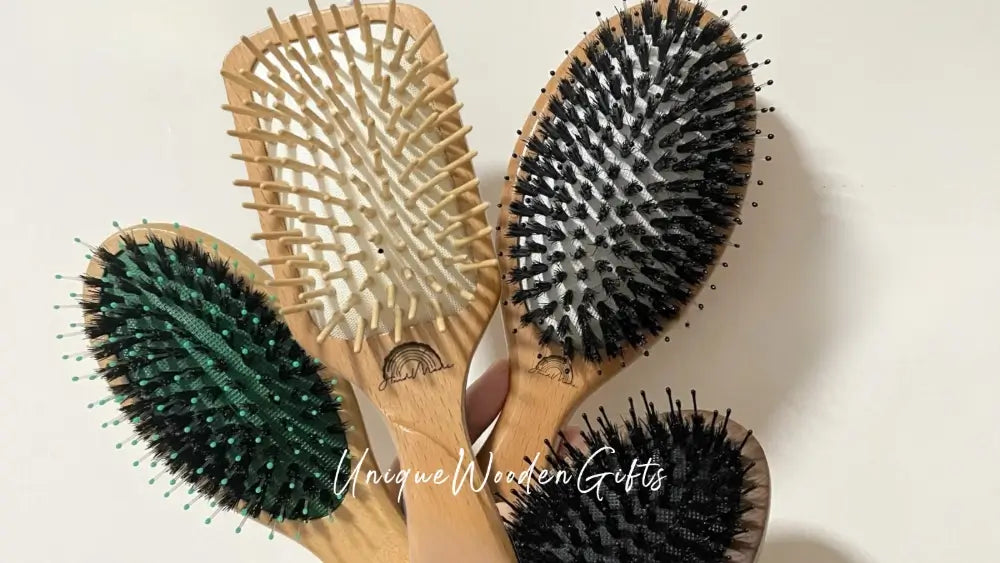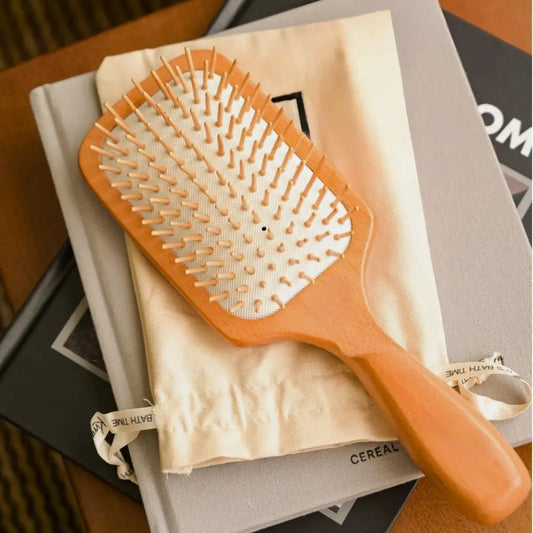
Wooden Comb Benefits (vs Plastic): The Anti-Static Truth for Hair & Beards
Share
Quick picks
- Daily smoothing & scalp comfort → anti-static wooden paddle brush
- Clean beard lines & even oil distribution → beard comb & boar-bristle brush set
- Curly/thick hair detangling + relaxing massage → wide-toothed wooden comb massager
Why Wooden, Not Plastic?
Less static, fewer flyaways. Plastic tends to accumulate charge as it moves through hair, which shows up as frizz and fluff. Finished wood disperses charge more readily, so strands lie flatter and look smoother.
Gentler on skin and strands. Properly rounded wooden teeth and polished edges reduce scratchy contact against the scalp or face, so you can apply pressure without the sharp “bite” of hard plastic seams.
Better oil distribution. Wooden teeth and boar bristles help lift tiny amounts of natural sebum (or added beard/hair oil) and carry it through the lengths, softening ends and improving the finish.
Sustainable feel, gift-ready look. Real wood varies in grain and tone, making each piece unique—and a more thoughtful upgrade over disposable plastic.
Explore the full range: Wooden Comb for Beard & Hair collection
Hair: Anti-Static, Smoother Strands
If your hair fluffs up in dry seasons or under office AC, switching tools alone can improve the finish.
Why it helps
- Static control: Fewer flyaways = neater silhouette with less product.
- Comfort: Rounded wooden pins flex with a cushioned base to diffuse pressure on the scalp.
- Detangling: The right spacing glides through knots with less tugging and breakage.
Recommended tool:
- FSC beech anti-static paddle brush — rounded wooden pins + high-rebound air cushion = smooth detangling and spa-level scalp relief.
At-home flow (daily)
- Towel-dry to 60–80% (avoid aggressive combing when soaking wet).
- Work the paddle brush from roots to ends in slow passes.
- For stubborn knots or thick/curly roots, finish with the wide-toothed massager in short, targeted stroke.

Beard: Clean Lines, Even Oil
Beard grooming benefits from a two-tool approach: a brush to clean and distribute, and a comb to shape.
Why it helps
- Even oiling: Boar bristles carry sebum or 2–3 drops of beard oil from roots to tips, softening stubble and calming fuzz.
- Defined edges: A compact wooden comb sets cheek, jaw, and moustache lines with control.
Recommended kit:
- Wooden Beard Comb & Boar-Bristle Brush Set — dual-sided pear-wood comb for various densities + dense boar bristles for clean-and-massage care.
Edge-clean routine (short to medium beards)
- Start dry.
- Drop 2–3 beads of oil across bristles (bristles facing up).
- Brush with the grain in short, light strokes: cheeks → jawline → chin; moustache center → outward.
- Switch to the comb for short, controlled passes: throat/neck up to the chin; neck sides upward; cheeks downward with growth; moustache center outward.

How to Use: Brush → Comb (Hair & Beard Routine)
Hair
- Prep: 60–80% dry.
- Brush first: Use the paddle brush to detangle and massage.
- Comb to finish: For curls/thick roots, use the wide-toothed massager on knots, then a few smoothing passes with the paddle brush.
Beard
- Brush first: Lift flakes and distribute natural/added oil with the boar-bristle brush.
- Comb to finish: Use the dual-sided beard comb to define lines and set the shape.
Care: Clean, Dry, Oil Lightly
Keeping wood healthy is simple and quick.
Daily quick clean (<1 min)
- Tap to dislodge hairs.
- Wipe teeth or bristles with a damp cloth/paper towel.
- Air-dry away from direct heat.
Monthly care
- For wooden surfaces, rub in a single drop of plant oil or hand cream. Wait 10 minutes, then buff with a soft cloth to keep the finish rich and smooth.
Don’ts
- Don’t soak wooden tools.
- Don’t leave in direct sun or on a radiator.
- Don’t yank through tight knots—switch to the wide-tooth first.
Vent-hole myth (paddle brushes)
- The small hole in the cushion is intentional. It lets air escape when pins compress and helps water drain after washing—no pin is missing.

Quick Picks
- Daily smoothing + scalp comfort → FSC Beech Anti-Static Paddle Brush
- Even oil + clean beard lines → Beard Comb & Boar-Bristle Brush Set
- Curly/thick detangling + massage → Wide-Toothed Wooden Comb Massager
FAQs
1. Are wooden combs really anti-static?
Wood builds up less charge in use than plastic, which helps reduce flyaways and the “puffed” look—especially in dry conditions.
2. Wooden comb vs plastic: which is better?
Plastic is cheap and available everywhere, but often adds static and feels scratchy. A well-finished wooden comb is gentler, reduces tugging, and helps spread oils evenly.
3. Can I use a wooden comb on wet hair/beard?
For least tension, groom hair at 60–80% dry and beards fully dry. If hair is soaking wet, start with very light passes or finger-detangle first.
4. How do I clean a wooden comb or boar-bristle brush?
Tap out hairs, wipe with a damp cloth, then air-dry. Once a month, apply a drop of oil to wood and buff.
5. Is initial shedding from a boar-bristle brush normal?
Yes—loose “floating” bristles from manufacturing may release at first. Hold bristles down, tap gently, and sweep them away before use.
Wooden vs Plastic: Side-by-Side
| Factor | Wooden Comb (U.W.G.) | Typical Plastic Comb |
| Static Control | Strong | Weak |
| Tugging Feel | Low | Medium-High |
| Oil Distribution | Even | Uneven |
| Scalp/Skin Comfort | High | Medium |
| Sustainability | High | Low |
| Gift-Worthiness | High | Low |
Build Your Routine
- Daily Smooth & Scalp Massage Set: Paddle Brush + Wide-Toothed Massager
- Beard Oil & Shape Kit: Beard Comb & Boar-Bristle Brush Set
Ready to switch off static and tugging? Start with the tool that fits your routine, then add the second piece for a complete, calming ritual.



